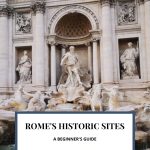Beginner’s guide to the top historic sites in Rome
Boasting a rich history and vast array of age-old sites, Rome – also known as the Eternal City – is one of the most iconic travel destinations in the world. Honestly, from the Colosseum and Trevi Fountain to the Pantheon and The Vatican, it’s hard not to be blown away by the slew of ancient wonders on your doorstep.
Note: This is a guest post by Danny Newman, who also supplied the photos, except where noted.
Disclosure: This article contains affiliate links. If you click on a link and make a purchase, I (Rachel) will receive a small commission. This will not affect your price.
In fact, there are so many incredible historic sites in Rome that it’s hard to know where to begin – especially when it’s your first time in the city! To help, I’m going to take you through a selection of these must-see historical attractions with detailed tips on what to expect when visiting them. Looking for an unforgettable experience exploring Rome’s historic sights? Keep reading.
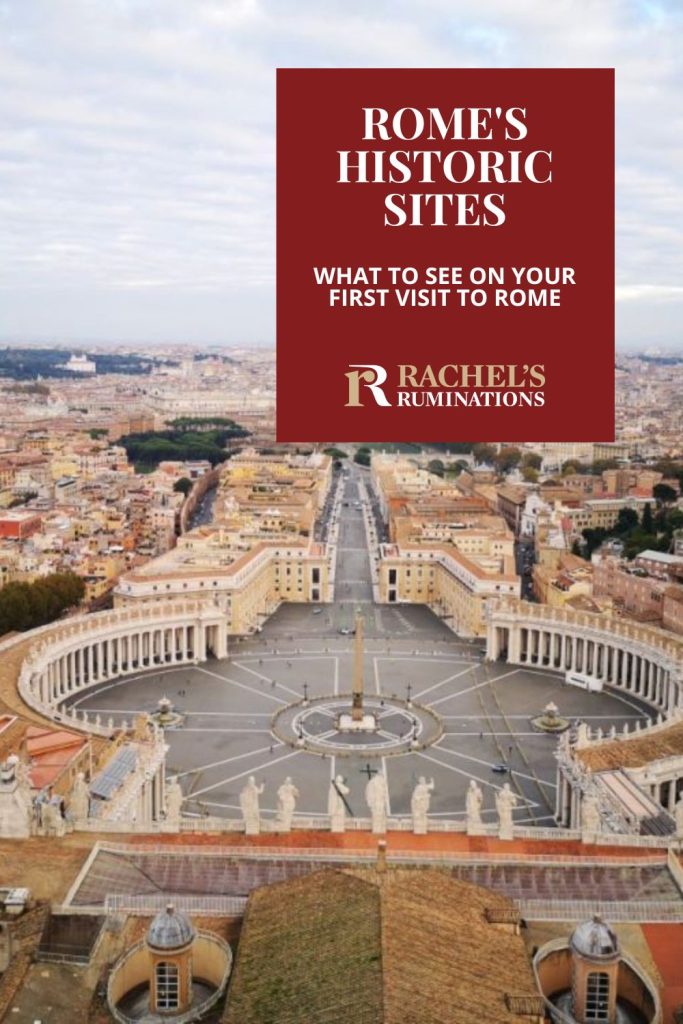
You’ll need several days to see the sights in Rome, so book your accommodations here!
Historic sights from Ancient Roman times
The Colosseum
The Colosseum is to Rome what Big Ben is to London: iconic.
One of the most famous landmarks in the world, visiting the Roman Colosseum is a gift for travel lovers and history buffs alike. Built around C.E. 70, this notorious amphitheater was used to stage gladiator battles, executions, animal hunts, and other public spectacles. It’s estimated that around 400,000 people were killed within its walls.
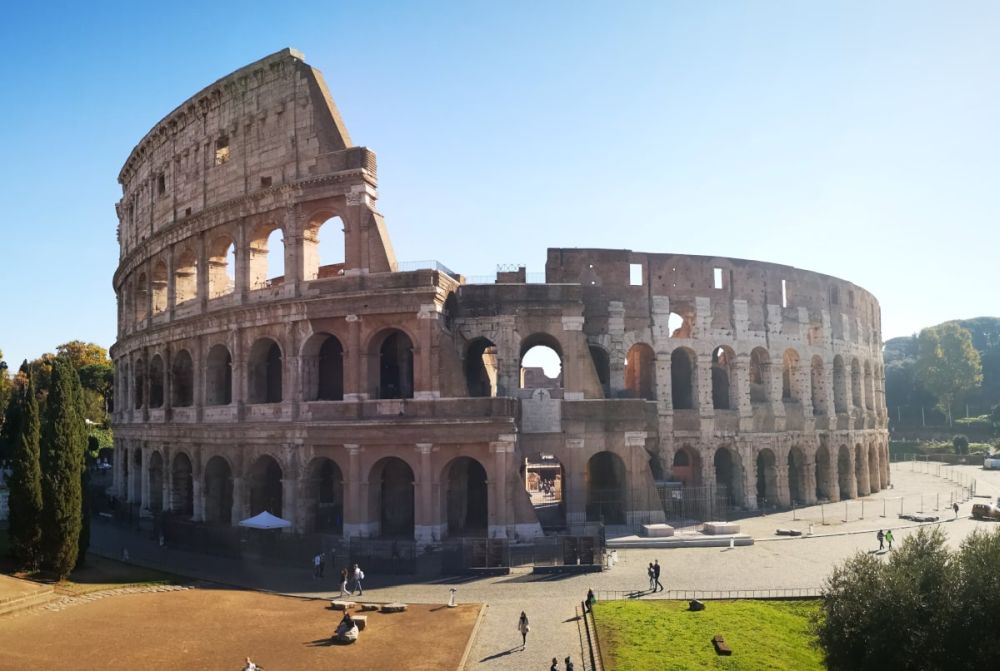
Today, the Colosseum stands as a symbol of the Roman empire’s culture and engineering prowess. Its architecture is impressive, to say the least, towering four stories high and with a total of 240 exterior arches.
You’ve probably seen it in pictures a thousand times before, but it’s still hard not to gawp when you see it in person for the first time.
Take note: The Colosseum’s opening hours change throughout the year; it always opens at 9:00, but the closing times vary from 19:15 in the summer to as early as 15:30 in February. Check their website to avoid disappointment. No matter when you go, the ticket office shuts an hour before closing time. I highly recommend you go early in the day to a) avoid the crowds and b) give yourself enough time to explore every nook and cranny of this magnificent structure.
The Colosseum: Getting to the Colosseum is easy. Just take metro line B to “Colosseo” station. If you’re travelling by bus, take number 38, 75, 175 or 271. The bus stop you need is Piazza del Colosseo. Hours: see website. Admission: Standard tickets cost €16, which also grants you entry to the Roman Forum (see below) and Palatine Hill. Website.
Buy your skip-the-line ticket for the Colosseum here.
The Roman Forum
The Roman Forum or Forum Romanum is another of Rome’s unmissable ancient sites.
Once the epicenter of political life in ancient Rome, the Forum was the site of public meetings and a venue for speeches; it was where senators gathered and victory processions marched; where criminals were brought to justice and commercial affairs took place. Its collection of ruins stand at the foot of the Capitoline Hill, one of the original seven hills of Rome around which the ancient city grew.
These days, the Roman Forum serves as an impressive reminder of the city’s past glory, with a vast array of ancient buildings and statues still on display. Some stand as if they were built recently; others lie in ruin. Nestled amongst the hustle and bustle of this modern city, it’s an incredible juxtaposition that must be seen to be believed. A few points of interest include:
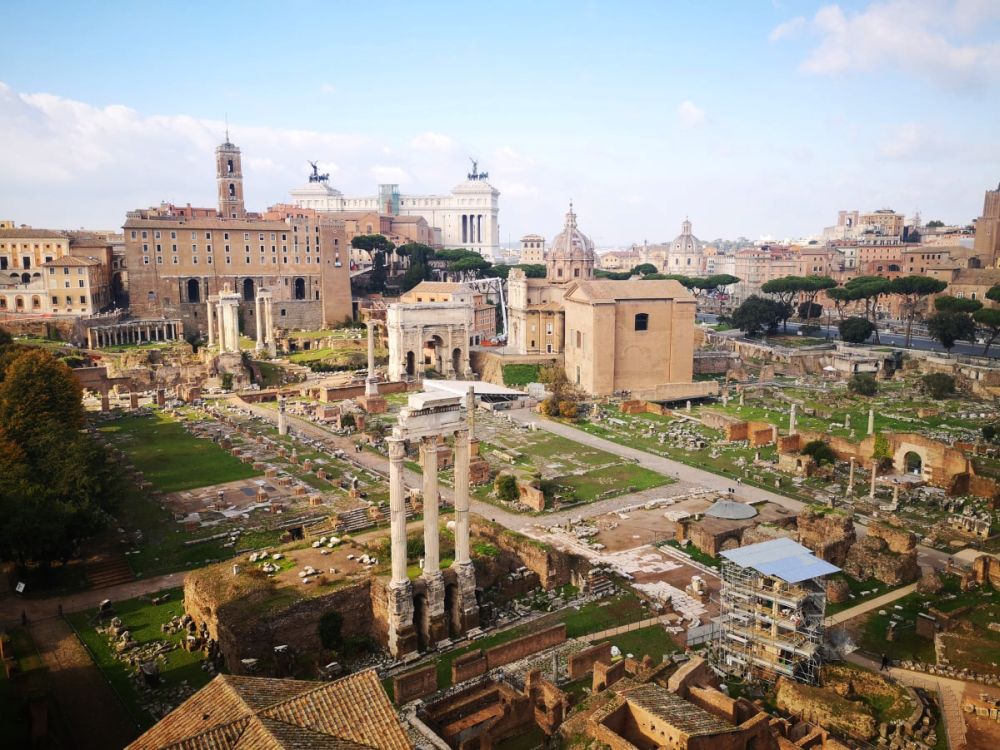
- The Temple of Saturn: While the current ruins here date to the 4th century AD, the original temple that stood on this site dates back to 497 BC. It probably housed an enormous statue of Saturn (a.k.a. Kronos). Later it served primarily as a public treasury for state funds.
- Arch of Septimius Severus: Built in 203 AD, this enormous archway honors Emperor Septimius Severus’s victory over the Parthians. It also honors his two sons who were appointed co-emperors after their father’s death.
- Temple of Vesta: This temple once housed sacred objects from Ancient Rome and contained a sacred fire that six so-called Vestals had to keep alight at all times. A part of the building was reconstructed in 1930.
- The House of the Vestal Virgins: This is where the six Vestal Virgins lived, and you can still see their large statues.
- Curia Julia: One of the most intact buildings in the Forum, the Curia Julia served as a meeting place for the Roman Senate. It has been damaged and reconstructed numerous times throughout history. The floor inside, with its geometric patterns in colored stone, dates to the 3rd century.
- The Temple of Romulus: Originally dedicated to Velerius Romulus, this little temple became a church in the early Middle Ages. You can still see the Medieval frescoes with Christian images.
- Arch of Titus: This arch holds detailed carvings inside the archway that depict Titus’s victory over the Judean rebellion. That was when the Roman army destroyed the Second Temple in Jerusalem.
- The Temple of Antonius and Faustina: Emperor Antoninus Pius built this temple to honor his wife, Faustina, but later, in the 1600s, a baroque facade was added when it was rededicated as a Catholic church.
- The Basilica of Maxentius: This very large building dates to the 4th century, but it was far larger originally; only three arches remain.
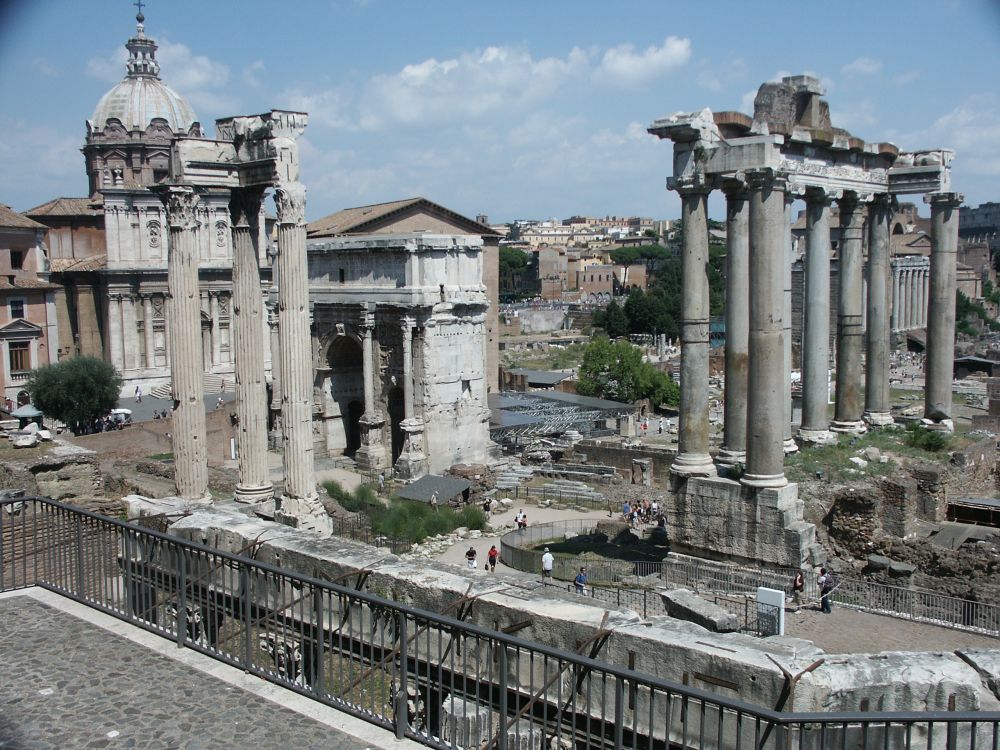
Tip: take some extra cash to buy some souvenirs from the vendors that hang around this part of the city!
The Roman Forum: The Forum is located right opposite the Colosseum, which is why many people choose to go from one to the other. Metro line B to “Colosseo” station. By bus, take number 38 or 75 if you’re coming from north Rome, or 175 and 271 if you’re coming from the south. The bus stop is Piazza del Colosseo. Hours: Same as the Colosseum; the ticket office closes an hour before closing time. Admission: A combination ticket that includes the Colosseum (but not the arena), the Forum and Palatine archeological area is €16. A full ticket, which also includes admission to all public areas of the Colosseum, is €22.
Buy your skip-the-line ticket to the Colosseum and the Roman Forum here.
Palatine Archeological Area
The Palatine Hill, right next door to the Forum, was the place where the Roman aristocracy built their homes in the first and second centuries BC. Over the next couple of centuries, Imperial palaces rose there, often overlapping earlier mansions. You can view various remnants that have been excavated. For example, the Cryptoporticus is a long, painted wall with mosaic floors. The House of Augustus has some wonderful mask paintings, and the House of Livia has some decoratively painted walls.
Palatine Archeological Area: Same as the Colosseum and the Forum (see above), accessible with the same combination ticket.
The Arch of Constantine
This triumphal arch dates to 315 AD. It marks the triumph of Emperor Constantine in the battle at Milvian Bridge against the forces of Maxentius a few years earlier. The reliefs on the arch that depict faces were taken from other Roman monuments and recarved to look like Constantine.
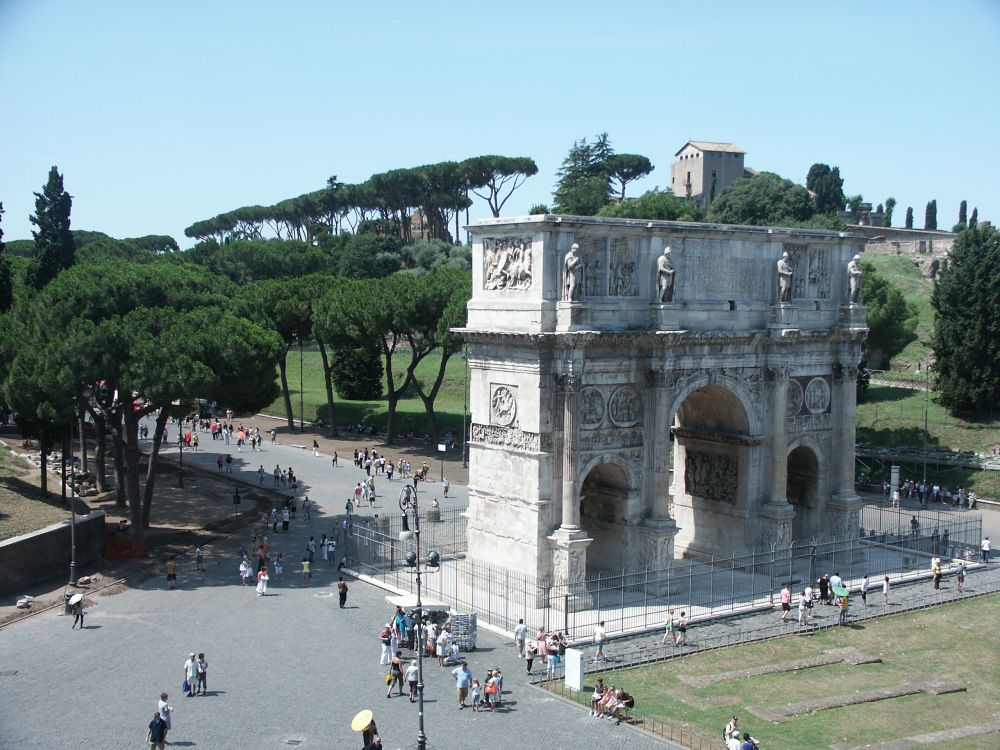
The Arch of Constantine: Next to the Colosseum. Open all the time. Admission is free.
The Domus Aurea
Also next to the Colosseum, the Domus Aurea was Emperor Nero’s palace and incorporated earlier palaces in its design. At the time, it was huge, and included many buildings, gardens, a lake, a vineyard – a Roman-period version of Versailles. Its walls would have been thoroughly decorated with frescoes, gold, glass and gems, all of which was removed by the emperors who came after him. They also filled in most of it and built new structures on top. A small excavated part can be seen today – it’s the part that was probably used for events rather than as living quarters.
Note that it’s chilly inside. Wear layers.
The Domus Aurea: Inside Colle Oppio Park, very near the Colosseum. Metro line B, Colosseo stop or bus lines 51, 85, or 87. Hours: Friday, Saturday and Sunday, 9:00-17:00. Admission: €15 and includes a guided tour with virtual reality glasses. Website.
If Ancient Rome is your thing, read these articles before you plan your next trip!
The Pantheon
The Pantheon is a true architectural wonder and one of the best-preserved historic sites in Rome. Located right at the heart of the city, this imposing building was first built by Emperor Hadrian somewhere around 118 to 128AD, as a temple to the gods. Later, in the 7th century, it became a Catholic church, which is probably why it is so well-preserved.
Hugely impressive to step foot inside, it’s famous for its enormous domed concrete roof with an oculus at its center, which allows natural light (and rain) to flood into the building. The oculus’s hole is about 8 meters (27ft) across. This mindboggling architectural achievement remains the largest unsupported dome in the world, 2000+ years after its construction.

What I loved most about visiting the Pantheon is that you can go inside for free. You can just walk in (often with barely any wait), witnessing its beautiful marble floors and walls adorned with statues and paintings from antiquity. It is still a church to this day – the Church of St Mary of the Martyrs – and holds tombs of various notables including several kings and the Renaissance painter Raphael.
For optimal viewing conditions, I recommend visiting early morning or late afternoon when there are fewer crowds. That way you can take your time, admiring its beauty without interruption.
The Pantheon: Piazza della Rotonda, close to several other popular attractions, including the Trevi Fountain and Spanish Steps. Hours: daily 9:00-19:00. Admission: free at the moment, but will go up to €5 sometime soon. For those under 25 yeras old it’ll be €2. The Pantheon’s website.
Castel Sant’Angelo
This imposing castle dates back to Hadrian’s rule; he had it built to be his mausoleum in the 2nd century AD. The structure later became a fortress. Then, with the advent of Christianity, it was converted into a castle, connected to St. Peter’s Basilica, and also a prison.
Today, Castel Sant’Angelo houses a museum of weaponry and has Renaissance frescoes and a papal apartment you can tour. You can enjoy baroque art here as well, for free: notice the statues on the pedestrian bridge. While the bridge was part of Hadrian’s original project – three of its arches are the original Roman constructions – a number of statues of biblical figures were added in the 16th and 17th century.
Castel Sant’Angelo: Parco della Mole Adriana. Nearest bus stop: Piazza Pia/Castel S. Angelo. Open Tuesday-Sunday 9:00-19:30, though the ticket office closes at 18:30. Admission: €14, but free on every first Sunday of the month.
Buy your fast-access ticket to Castel Sant’Angelo here.
Via Appia Antica (Appian Way)
The Romans were masters at road building, creating them wherever the Roman Empire extended. The Appian Way between Rome and Brindisi was the first that was used expressly for transporting troops. Made of dirt at first, it was later paved with stones fitting closely together, graded to be slightly higher in the middle so water would run off. The Roman-era cement is mostly gone now, so the road, where it still exists, is rougher than it used to be.
The Appian Way starts in Rome. You can walk it from one end of the Circus Maximus. That’s an area that was a huge chariot racetrack in Roman times, but is now a park. While you can walk or bike several miles out of the city on the Via Appia Antica, you can get a sense of it without walking too far. After the first two or so kilometers (about a mile) – passing some interesting tombs and catacombs – you’ll see a very well-preserved section. This road is still intact after almost 2000 years! Look closely and you may be able to spot places where the wagons wore grooves in the stone.
You might also enjoy Rachel’s musings from a 2009 trip to Rome: On not being a VIP in Rome.
Major Baroque and Renaissance sights
The historic sites in Rome aren’t all about the ancient Romans, though. There are plenty of things to see from later periods, especially Renaissance and Baroque art and architecture. Take a look here as well for plenty of famous Roman scultures.
The Vatican
Home to the Pope and headquarters of the Catholic Church, the Vatican is a site of monumental significance in Rome. Furthermore, Vatican City-State was established in 1929 by a treaty between Italy and the Holy See, making it an independent state within the city!
Whether you’re religious or not, though, this UNESCO site deserves a spot at the top of your Italy bucket list. Inside, there are several world-famous attractions, including St Peter’s Basilica, the Sistine Chapel, and the Raphael Rooms, as well as countless galleries to explore. I’m not usually a big fan of guided tours, but it’s worth paying for one at the Vatican to help you appreciate everything you see here.
Book this guided tour, which includes skip-the-line tickets.
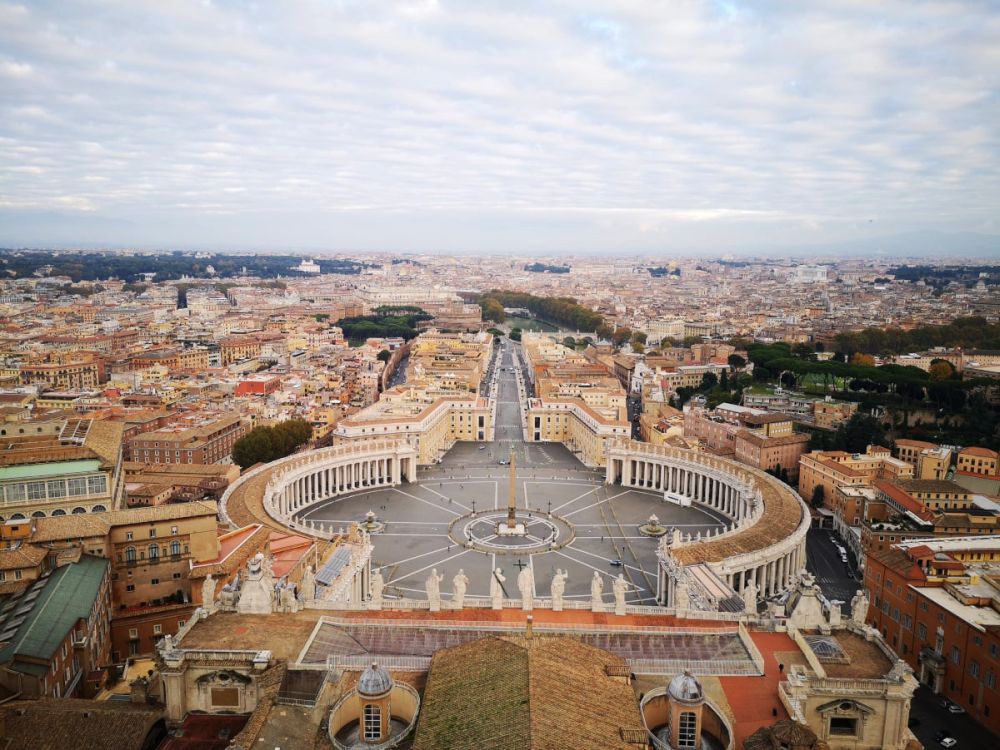
- St Peter’s Square: Even if you don’t want to or can’t pay the price to go inside the Vatican Museums, you can at least see this breathtaking plaza, Piazza San Pietro. Bernini designed it, with its graceful curved porticoes and statues of saints. The obelisk in the center was brought to Rome from Egypt.
- St Peter’s Basilica: For Catholics the most important church in the world, it’s also among the largest, completed in its current form in 1626. In the basilica, you’ll see works of Renaissance art including Michelangelo’s Pieta and the huge and incredibly ornate baldachin (ceremonial canopy), a Bernini design. Notice how huge the dome is. Climb to the top of the dome to see a beautiful view down to St Peter’s Square.
- The Vatican Museums: It would take days or perhaps weeks to see everything in the Vatican. The over 50 collections range from ancient Etruscan and Egyptian art to early Christian and Medieval art, all the way to a modern religious art collection. There’s also a collection of medieval ceramics and mosaics, and galleries holding maps, chandeliers and Flemish tapestries, just to give a partial list.
- The Sistine Chapel: The ceiling of the Sistine Chapel is Michelangelo’s 16th-century masterpiece. Other artists contributed to other parts of the hall, including Botticelli.
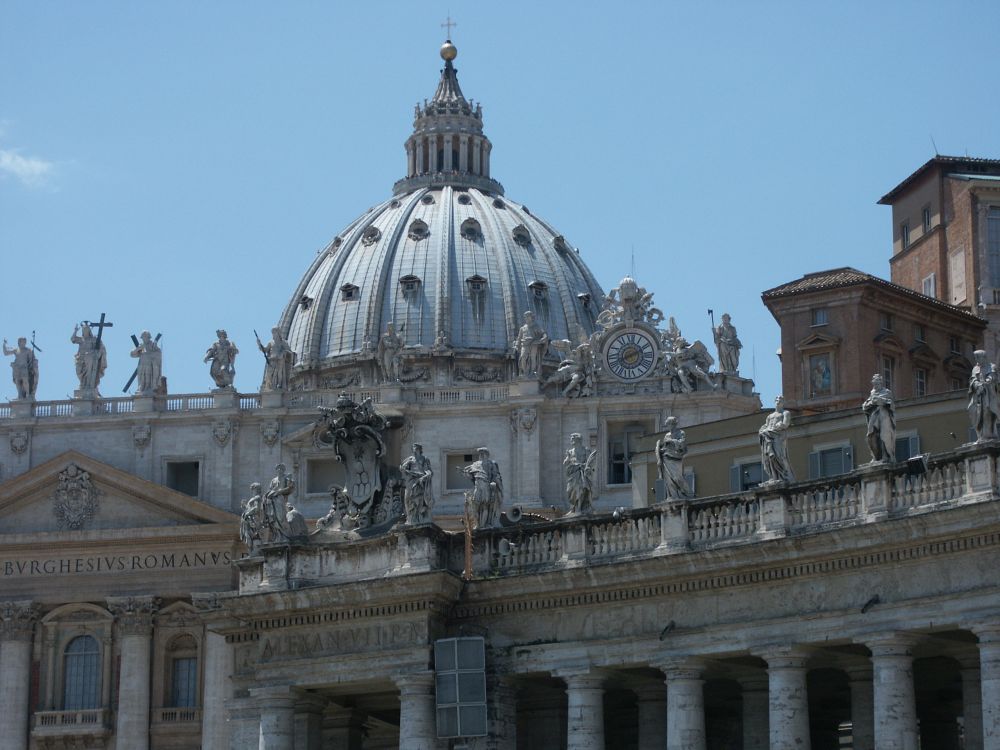
Once again, since this is such a popular destination it can get incredibly crowded. Try to go early in the morning or later in the afternoon when crowds tend to thin out a bit. Additionally, make sure you dress appropriately: shorts/skirts above knee length are not allowed inside churches here. Shoulders should also be covered. When you enter, you should expect long queues and strict baggage searches, similar to what you find at airports.
The Vatican is located just outside of central Rome and is easily accessible by public transport (and a bit of walking!). The nearest metro station is Ottaviano. There are two entrances: from Viale Vaticano on the northern side and through St. Peter’s Basilica from Via Della Conciliazione. The best way to approach the Vatican is from Castel Sant’Angelo. Walking to the Vatican along the Via della Concilazione will lend the appropriate sense of awe as you near St Peter’s Square.
The Vatican: Open Monday-Saturday 9:00-18:00 (with last entry at 16:00), with extended hours during peak tourist season. Admission to the plaza and Vatican City is free, but admission to the museums and the Sistine Chapel is €17. On the last Sunday of each month it’s open 9:00-14:00 with free entry. Book ahead if at all possible to avoid long lines and potentially not being able to enter.
Click here to read lots of fun facts about Rome!
The Trevi Fountain
Often called the most beautiful fountain in Rome, the Fontana di Trevi is another popular tourist attraction that combines history with aesthetic beauty.
Located at the junction of three roads, it was designed by Nicola Salvi and built in 1762 by Giuseppe Pannini. Today it is considered a masterpiece of Baroque art. It stands 20 metres wide and 26 metres tall, featuring an intricately carved statue of Neptune surrounded by sea gods and goddesses. It still has a connection, nevertheless, to ancient times, because it marks the end of the Vergine aqueduct, part of the ancient Roman water system.
Visiting the fountain is a memorable experience – partly for the mass of humanity you’ll see posing for selfies there, but mainly because it’s such an impressive sight, especially at night, when it’s lit up.
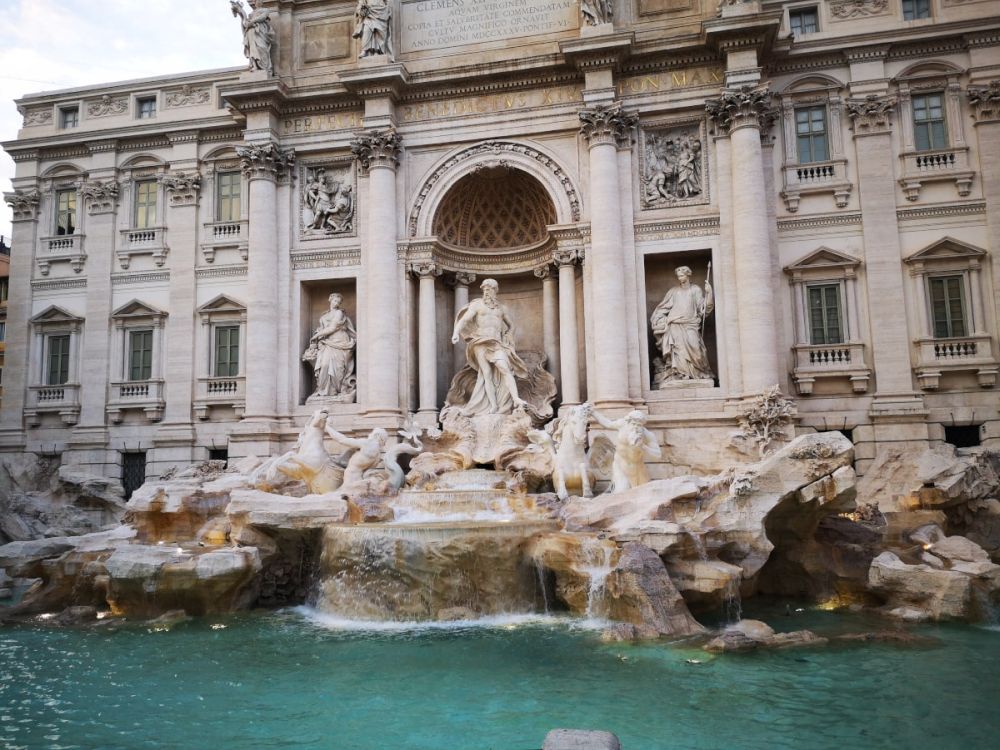
The fountain is a short walk away from the Piazza Barberini metro station. Otherwise, I recommend you pay it a visit one afternoon while exploring Rome’s beautiful city centre. It’s a short walk from nearby attractions such as the Spanish Steps and the Pantheon. Take note though: if you don’t mind seeing it unlit, the best time to visit is early morning, before all the crowds arrive!
Seeing the Trevi Fountain is totally free. However, throwing coins into the fountain has become a tradition among tourists. Courtesy of a 1954 movie called “Three Coins in the Fountain”, the story goes that throwing one coin into the fountain means you’ll return to Rome. Throwing two coins means you’ll fall in love with an Italian. Throwing three coins means you’ll end up marrying the person you just met!
There are even particular rules around how to throw the coin. You have to stand with your back to the fountain and use your right hand to toss it over your left shoulder. If you want to give it a try, bring along some change so you can join in on the ritual.
Trevi Fountain: Piazza di Trevi. Open 24 hours. Admission: free.
Other baroque architecture
By the way, there are plenty of other places to see Baroque art and architecture in the city of Rome, besides the Trevi Fountain. Here’s just a sampling:
- Piazza Navona may be the best place for the Baroque. Look for the Pamphili Palace (Palazzo Pamphili) and three ornate fountains in the square dating from the 16th and 17th centuries. The one in the center is Fontana dei Quattro Fiume (Fountain of the Four Rivers) by Bernini, but the obelisk on top of it is older. Dating to the 4th century, it came from the ancient Circus of Maxentius site outside the city. Giacomo della Porta designed the Fontana dei Moro but Bernina contributed too; he added the central figure who is fighting the dolphin. Della Porta also created the Fountain of Neptune, and again a central figure was added, this time not until the 19th century by Antonio Della Bitta.
- Sant’Agnese church pre-dates the baroque period but was redone in baroque style.
- The Church of Sant’Andrea was designed by Bernini.
- Church of the Gesú, a Jesuit church, is considered one of the first baroque facades, done by Giacomo Della Porta.
- San Carlo alla Quattro Fontane, designed by Francesco Borromini, has a uniquely undulating facade, and these curved forms continue in the interior.
- The Piazza di Spagna has a Bernini-designed fountain called the Fontana della Barcaccia in its center.
- Piazza Barberini has a wonderful Bernini-designed fountain as well: the Fontana del Tritone.
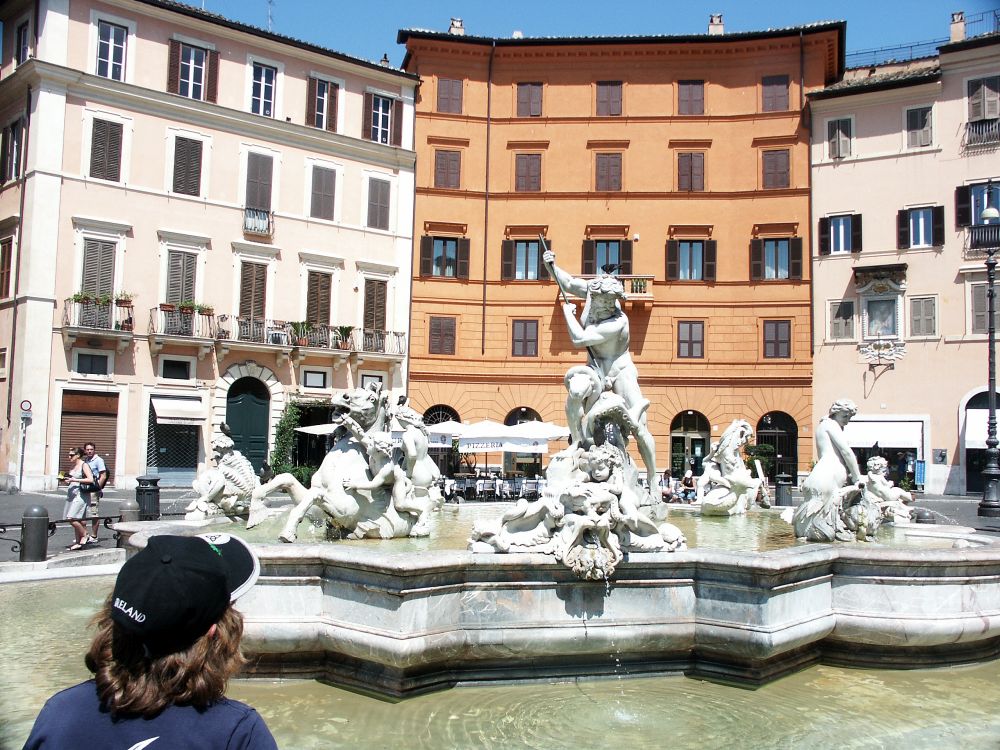
The Spanish Steps
Located in the centre of Rome, the Spanish Steps connect Piazza di Spagna to the Piazza Trinita dei Monti and its eponymous church. A wonderful collection of curved stairways, fountains, and terraces, this grand staircase dates back to 1723. It offers great views over the city from the top. The Trinita dei Monti church enjoyed the patronage of the French kings at the time, and the steps connected the church at the top to the Spanish Embassy at the bottom.
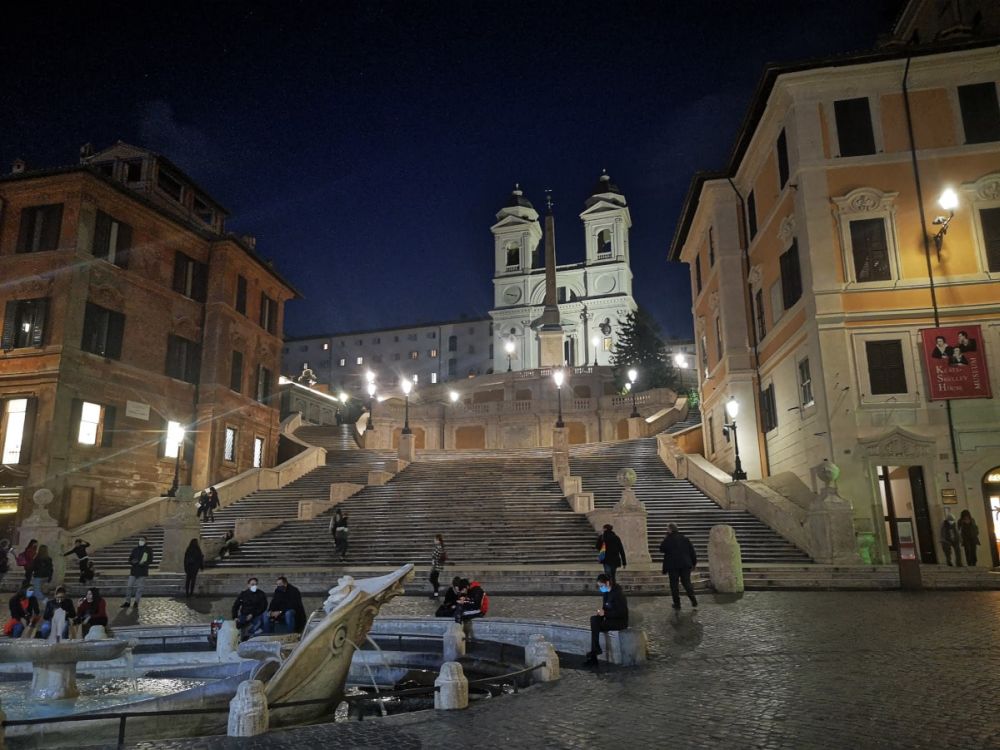
Nearby attractions include Villa Medici, Keats-Shelley Memorial House, and Galleria Borghese, where visitors can admire artworks by Caravaggio and Raphael, among many others. You can access the Spanish Steps from Via Condotti, which is also a great place for some upmarket shopping!
The area at the base of the steps is also a great location to grab a drink or bite to eat, all the while gazing upon the 138 Roman travertine steps that comprise this historic site. They’re open at all times and free to both see and ascend. Beware, though: it’s illegal to sit on the actual stairs themselves.
Spanish Steps: Piazza di Spagna. Open 24 hours. Admission: free.
Don’t forget to book your accommodations!
Dive into history in Rome
It’s literally impossible to spend time in Rome without seeing its historical sites. Ancient buildings and monuments lie in wait around every corner, offering a fascinating insight into the city’s storied past.
At a minimum, make sure to see the Colosseum, the Roman Forum, the Trevi Fountain, the Spanish Steps, the Pantheon and the Vatican. These are all the best places that I wholeheartedly recommend for your trip, and you could fit them into a four-day visit with no problem. With any luck, the information in this article will help you get there and enjoy them! Another bit of advice: read this article about keeping safe in Rome before you go.
Want to learn more about this magical part of the world? Click to discover an amazing day trip from Rome to Ostia Antica. This is a set of well-preserved ancient ruins – what remains of an important trading port that served for the ancient Romans as a gateway to Rome.

My travel recommendations
Planning travel
- Skyscanner is where I always start my flight searches.
- Booking.com is the company I use most for finding accommodations. If you prefer, Expedia offers more or less the same.
- Discover Cars offers an easy way to compare prices from all of the major car-rental companies in one place.
- Use Viator or GetYourGuide to find walking tours, day tours, airport pickups, city cards, tickets and whatever else you need at your destination.
- Bookmundi is great when you’re looking for a longer tour of a few days to a few weeks, private or with a group, pretty much anywhere in the world. Lots of different tour companies list their tours here, so you can comparison shop.
- GetTransfer is the place to book your airport-to-hotel transfers (and vice-versa). It’s so reassuring to have this all set up and paid for ahead of time, rather than having to make decisions after a long, tiring flight!
- Buy a GoCity Pass when you’re planning to do a lot of sightseeing on a city trip. It can save you a lot on admissions to museums and other attractions in big cities like New York and Amsterdam.
Other travel-related items
- It’s really awkward to have to rely on WIFI when you travel overseas. I’ve tried several e-sim cards, and GigSky’s e-sim was the one that was easiest to activate and use. You buy it through their app and activate it when you need it. Use the code RACHEL10 to get a 10% discount!
- Another option I just recently tried for the first time is a portable wifi modem by WifiCandy. It supports up to 8 devices and you just carry it along in your pocket or bag! If you’re traveling with a family or group, it might end up cheaper to use than an e-sim. Use the code RACHELSRUMINATIONS for a 10% discount.
- I’m a fan of SCOTTeVEST’s jackets and vests because when I wear one, I don’t have to carry a handbag. I feel like all my stuff is safer when I travel because it’s in inside pockets close to my body.
- I use ExpressVPN on my phone and laptop when I travel. It keeps me safe from hackers when I use public or hotel wifi.



